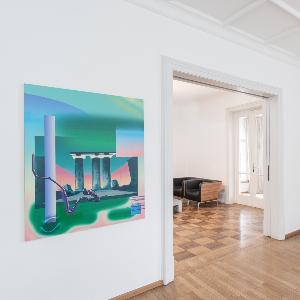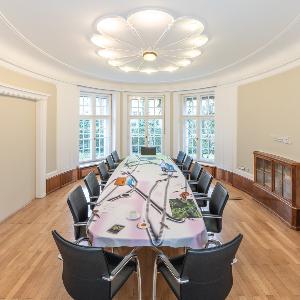Art at CAS: Do Your Own Research Center
23 Jun 2023
Artist Niko Abramidis & NE has transformed the Center for Advanced Studies into the headquarters of a mysterious species.
23 Jun 2023
Artist Niko Abramidis & NE has transformed the Center for Advanced Studies into the headquarters of a mysterious species.

“Art has become a significant component of interdisciplinary exchange at CAS,” says Managing Director Annette Meyer. | © CAS
Enter the Center for Advanced Studies (CAS) and you find yourself in the headquarters of a curious species: Munich artist Niko Abramidis & NE has transformed the house on Seestrasse near the English Garden into a den for lizard people: “a headquarters of secret research, knowledge discovery, and knowledge generation,” as the artist himself describes it.
Visitors to the Center for Advanced Studies, which provides a forum at LMU for interdisciplinary exchange and various forms of collaborative research, are greeted by a new handwritten sign on its fence: Do Your Own Research Center (DYOR U). This center “serves as a think tank to open up scientific knowledge encrypted by archaic codes and to provide substantial insights into the future,” writes CAS on its homepage about the artistic repurposing of its rooms.
How ideologies originate and how we try to decipher our world is a sort of leitmotif running through the exhibition.Annette Meyer, Managing Director of CAS
“How ideologies originate and how we try to decipher our world is a sort of leitmotif running through the exhibition,” says Dr. Annette Meyer, Managing Director of CAS, as she gives a guided tour through the rooms. Niko Abramidis, who studied under Julian Rosefeldt and Markus Oehlen at the Academy of Fine Arts in Munich and under Byung-Chul Han at the College of Fine Arts in Berlin, is interested in a broad range of scientific topics. He has been a guest at CAS on several occasions and regularly takes part in events and scientific conferences. In his own New World Network research group, which includes artists, scientists, blockchain developers, and business people, he explores questions relating to artificial intelligence and self-learning technologies, among other subjects.
“Abramidis takes scientific methods very seriously. But he also interrogates them and makes us aware how insufficient our approaches can sometimes be. And naturally, he pokes some fun as well,” says Annette Meyer. In Abramidis’ work, there is a big focus on semiotic systems: The walls of CAS / DYOR U, for example, feature artifacts of the lizard people, ominous beings which might come from the past or from the future. “In any case, one gets the impression that the species collects and tries to decode these objects which it has created or inherited,” says Meyer.

Do Your Own Research Center | © CAS
Games with signs, symbols, and ciphers recur in many works of the artist, who was born in 1987. For CAS, Abramidis has created paintings and sculptures that can seem archaic and ultra-modern at the same time. On the first floor of the house, there is a steel throne, which holds modern technology in its interior. With a keypad and a trackball embedded in the armrest, it recalls the iconic armchairs of James Bond villains. Yellow glasses lie around, which the lizard people use to observe the artifacts. Perhaps this eyewear helps them decipher things or allows them draw certain conclusions. Also lying around is virtual money, which can be used to purchase NTFs – that is to say, digital shares in the artworks.
The large table in the CAS conference room is decked out for an unusual meeting. Its printed tablecloth suggests a playful board meeting in which members watch cat pictures on digital gadgets, eat a lot of cookies, and smoke e-cigarettes. Books by experimental science fiction authors such as J.G. Ballard, Tom McCarthy, and Philip K. Dick line the shelves.
Reliefs recalling cave paintings – and works in oil adorn the walls on the first and second floors of CAS. Almost all the paintings in the exhibition were partly created using AI. Various elements of the pictures were generated with the familiar open-source software Stable Diffusion, which was developed at LMU, and which Niko Abramidis fed with various buzzwords to get the deep learning text-to-image generator to paint certain motifs.
Abramidis tells of an inspiring discussion he had recently with Professor Björn Ommer, who developed the algorithm behind Stable Diffusion: “From different perspectives, we’ve both grappled with questions of transparency and provenance – how can we determine the authenticity of pictures and information in the future? There must be transparency in relation to production processes and origin. Before now, a lot has happened in a black box. Only when that changes will there be trust.”
The semesterly exhibitions at CAS featuring different artists are always accompanied by scientific events. For example, Professor Frauke Kreuter, Chair of Statistics and Data Science in Social Sciences and the Humanities at LMU, delivered an introduction to Abramidis’ works at the opening of DYOR U. In the respective catalogs to the exhibitions, scientists from various research areas write texts about the artworks.
“There’s usually also an event with the artist during the semester, such as a panel discussion with researchers, who illuminate a topic from a different perspective,” says Annette Meyer.
On 29 June 2023, Niko Abramidis will meet the putative favorite author of the lizard people at CAS – Tom McCarthy. The writer and artist, who has twice been nominated for the Booker Prize, is General Secretary of the International Necronautical Society, a semi-fictional avantgarde network. Chairing the discussion about myth and literary fiction will be Professor Claudia Olk, Chair of English and Comparative Literature at LMU.
For 15 years now, CAS has been inviting artists to exhibit their works at its building on Seestrasse or at its branch on Friedrichstrasse – and has become a popular venue for art lovers and for established and emerging artists. Call-outs to present art at CAS attract many applicants.
In choosing an artist, the CAS board places an emphasis on dialog between art and science. Often the artists, as is the case with Niko Abramidis, are placed in interdisciplinary groups or engage with scientific questions and approaches. Past exhibitor Ugo Dossi, for example, explored stardust as part of the Stardust Group. In the following semester, the exhibiting artist was Ena Oppenheimer, who is interested in physical phenomena and questions of perception. In collaboration with the Pinakothek der Moderne gallery in Munich, two works by Joseph Beuys have also been presented at the Center for Advanced Studies.
Art is a way of looking that does not attempt to limit the complexity of an object in order to get a handle on it. Artistic approaches can also offer methodological inspiration, when it’s a matter of leaving beaten tracks and seeking new ones.Annette Meyer
At CAS, art is “a complement to the groups working beyond disciplinary boundaries that we forge here,” says Annette Meyer. Art offers an opportunity, she notes, to add other, new perspectives to scientific viewpoints, which are bound to specific practices and codes, and thus open up discourse. “Art is a way of looking that does not attempt to limit the complexity of an object in order to get a handle on it. Artistic approaches can also offer methodological inspiration, when it’s a matter of leaving beaten tracks and seeking new ones.” Undoubtedly, the artifacts of the lizard people, which can be seen at CAS until 4 August, are playing their part in this process.
Niko Abramidis & NE: website
Art at CAS: artists and exhibitions